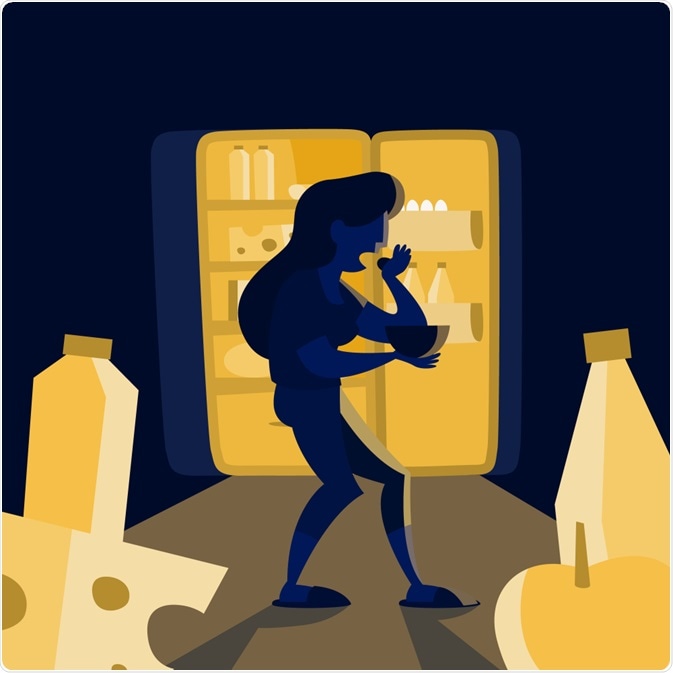The signs and symptoms that are characteristic of a binge-eating disorder primarily relate to the individual’s eating habits and relationship with food, rather than their physical appearance or body shape. While most affected patients are overweight, some people with binge-eating disorder have normal body weights and most obese people do not have binge-eating disorder.

Image Credit: Inspiring / Shutterstock.com
The binge-eating cycle
While it is considered normal for individuals to overeat on certain occasions, such as festive holidays and events, excessive eating on a habitual basis can lead to associated feelings of shame and the presentation of a binge-eating disorder.
People with a binge-eating disorder often cycle through the following distinct stages that characterize the condition:
- Strict dieting
- Obsession with body shape and weight
- Tension or anxiety due to cravings for certain foods
- Binge-eating large quantities of food in a short time frame (e.g. 3,000-5,000 calories in 1-2 hours.)
- Shame or disgust about binge-eating habits and renewal of dieting to control weight
Distinct from individuals who suffer from bulimia nervosa, people with a binge-eating disorder do not tend to purge the calories consumed following a binge-eating session. Instead, they continue with the current diet or to eat normal meals until the next binge-eating session.
Behavioral signs and symptoms
The behavior of an individual with a binge-eating disorder is often the starkest sign of the disorder, particularly in the way that they interact with food. These characteristic behaviors may include:
- Consuming large quantities of food in a short duration of time
- Continuing to eat even when full
- Eating alone more often than usual
- Inability to stop or control eating habits
- Frequent episodes of dieting without evidence of weight loss
- Attempting to hide evidence of binge-eating (e.g., hiding food packaging)
- Tendency to hoard or stockpile food
Emotional signs and symptoms
The emotional symptoms that present according to the individual’s relationship with food and their eating habits are hallmark of binge-eating disorder. They may include:
- Depression or anxiety
- Stress or tension that is relieved by eating
- Lack of control in quantity of food consumption
- Shame, disgust, and/or embarrassment about eating behavior
- Desperation to control body weight and eating habits
The emotional component of a binge-eating disorder is often the greatest factor that inhibits an individual from following normal eating patterns and prompts them to seek treatment for the disorder.
Other effects
An individual affected by a binge-eating disorder will often report related effects in many other facets of their life.
For example, self-confidence can be reduced as a result of feeling out of control of food consumption habits. This can then have a significant effect on their performance at school or work, as well as have an impact on social relationships and activities.
Other conditions that are linked to the binge-eating disorder include:
- Insomnia
- Depression
- Anxiety
- Substance abuse
- Suicidal thoughts
- Weight gain
The associated weight gain and increased risk of obesity can also lead to numerous medical complications, such as type 2 diabetes mellitus, gallbladder disease, hypercholesterolemia, hypertension, cardiovascular disease, osteoarthritis, gastrointestinal disorders, sleep apnea, and cancer.
DSM-5 diagnostic criteria
The diagnostic criteria for a binge-eating disorder according to the diagnostic and statistical manual of mental disorders includes:
- Recurrent binge-eating episodes, either eating a larger quantity of food within a discrete period or feeling out of control of food consumption during episodes.
- Binge eating episodes associated with eating more rapidly, until uncomfortably full, alone or without feeling hungry, and feeling of shame and disgust afterward.
- Distress about eating habits and binge-eating
- Binge-eating episodes occur at least once a week for at least 3 months
- Not associated with compensatory behavior or purging of calories that are linked to bulimia nervosa diagnosis.
References
Further Reading